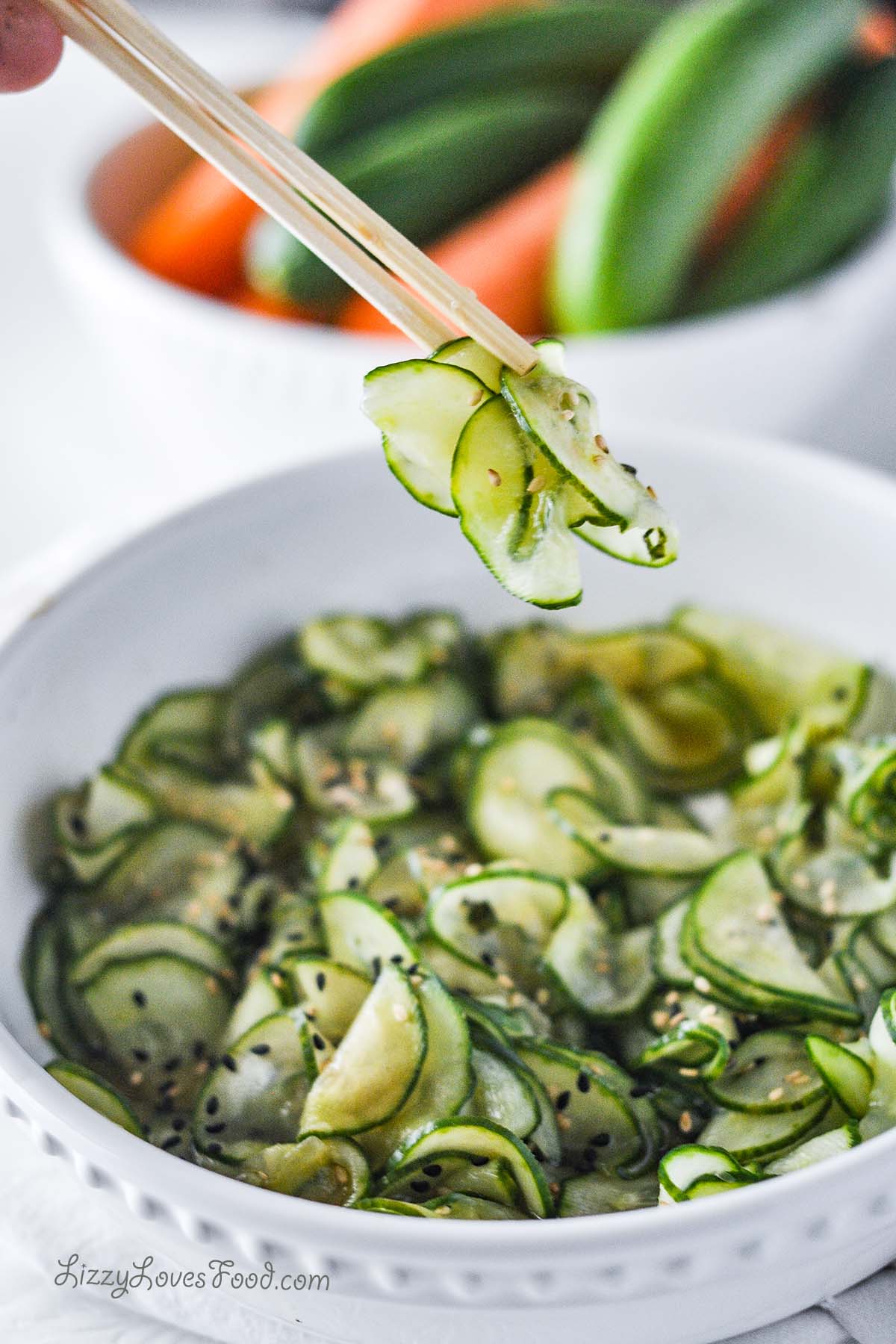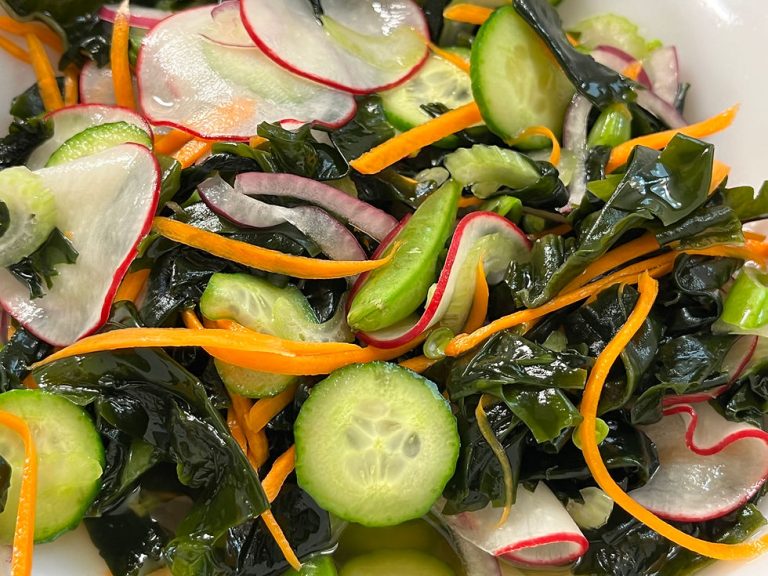Cucumber Sunomono: A Refreshing and Healthy Japanese Salad for Every Meal
Cucumber sunomono has its roots in Japanese cuisine, where fresh ingredients and delicate flavors dominate. Historically, sunomono refers to dishes dressed in vinegar, combining “su” (vinegar) with “mono” (things). This style of preparation dates back to the Edo period (1603-1868), showcasing Japan’s long-standing appreciation for vinegared foods. You’ll find variations of sunomono across different regions in Japan, each bringing a unique twist to the traditional recipe.
Key Ingredients and Variations
The basic ingredients for cucumber sunomono include:
- Cucumber: Thinly sliced, usually Japanese cucumbers due to their crisp texture and fewer seeds, but Persian cucumbers are also suitable.
- Vinegar: Rice vinegar is the preferred choice, offering mild acidity. Seasoned rice vinegar can replace plain rice vinegar for added flavor.
- Sugar: A small amount balances the vinegar’s acidity, giving the dish its characteristic sweet-tangy taste.
- Salt: Enhances the cucumbers’ flavor and helps draw out excess moisture.
Variations can include additional elements such as:
- Seafood: Ingredients like octopus or shrimp add protein, enhancing the nutritional profile.
- Sesame Seeds: Toasted sesame seeds provide a nutty flavor and additional texture.
- Wakame: Seaweed is often added, offering a different texture and a boost of umami.
Experiment with these variations to discover new flavors while maintaining the dish’s refreshing essence.
How to Make Cucumber Sunomono at Home
Step-by-Step Recipe
- Gather Ingredients: Collect 2-3 Japanese cucumbers, 1/4 cup rice vinegar, 1 tablespoon sugar, 1/2 teaspoon salt, and optional additions like sliced seafood or wakame seaweed.
- Prepare Cucumbers: Slice the cucumbers thinly using a mandoline slicer for uniformity. Place slices in a bowl with salt and let them sit for 5 minutes. Rinse thoroughly and squeeze out excess water.
- Make Dressing: Combine rice vinegar, sugar, and a pinch of salt in a bowl. Stir until the sugar dissolves completely.
- Mix Salad: Add the cucumbers to the dressing. Toss well to ensure even coating. For added flavor, include optional ingredients like seafood or wakame seaweed.
- Chill and Serve: Refrigerate the salad for at least 30 minutes before serving. Serve sunomono chilled, garnished with sesame seeds for extra texture.
- Use Fresh Cucumbers: Select firm, unblemished cucumbers to ensure crisp texture. Freshness directly affects the salad’s quality.
- Adjust Sweetness: Modify the sugar quantity based on your preference. Some enjoy a sweeter sunomono, while others prefer a tangy profile.
- Enhance Flavors: Incorporate additions like julienned carrots or finely sliced red onions for extra crunch and color variety.
- Balance Texture: Ensure cucumbers are evenly sliced and well-drained to avoid sogginess. Uniform slices promote even absorption of dressing.
- Serve Cold: Chilling the salad enhances its refreshing qualities, making it a perfect side dish for warm weather.
By following these steps and tips, you can make an authentic and refreshing cucumber sunomono at home, enhancing your Japanese dining experience.
Health Benefits of Cucumber Sunomono
Nutritional Breakdown
Cucumber sunomono offers a nutritious profile. Each serving typically contains low calories, making it suitable for those monitoring their intake. Cucumbers primarily comprise water, offering hydration benefits. Rice vinegar, a key ingredient, includes small amounts of acetic acid which can aid digestion. Adding ingredients like sesame seeds or wakame seaweed increases the dish’s nutritional density.
Why It’s Good for You
Adopting cucumber sunomono in your diet can provide multiple health advantages. Cucumbers contain antioxidants like beta-carotene, which helps combat oxidative stress. The high water content in cucumbers promotes hydration and supports kidney function. Rice vinegar’s acetic acid has probiotic properties that improve gut health. Incorporating wakame seaweed enriches the dish with iodine, essential for thyroid function, while sesame seeds add healthy fats and proteins. This combination makes cucumber sunomono a delicious way to enhance your overall well-being.
Pairing Cucumber Sunomono with Other Dishes
Ideal Combinations for Meals
Cucumber sunomono pairs well with a wide variety of meals. For instance, it complements sushi rolls, sashimi, and tempura. The dish’s acidity helps balance the flavors and cuts through the richness of oily fish or fried items. It also works well with grilled meats, including teriyaki salmon, chicken yakitori, and beef yakiniku. The light, crunchy texture of cucumber sunomono adds a refreshing element to these meals.
Creative Serving Ideas
There are several ways to incorporate cucumber sunomono in creative serving ideas. Serve it as a starter before a multi-course meal to cleanse the palate. For fusion cuisine, use it as an accompaniment to tacos, sandwiches, or burgers. Include it in a poke bowl alongside marinated tuna, avocado, and rice for added crunch and flavor. You can also garnish it with sesame seeds, sliced red chili, or pickled ginger to enhance visual appeal and taste.
Conclusion
Cucumber sunomono isn’t just a delightful addition to your meal; it’s a celebration of simplicity and flavor. Its deep-rooted history and versatility make it a must-try for anyone looking to explore Japanese cuisine. Whether you’re pairing it with traditional dishes or getting creative with modern fusion, this refreshing salad is sure to impress. Embrace the health benefits and enjoy the burst of flavor that cucumber sunomono brings to your table. Dive into its rich heritage and let your culinary adventures flourish.






